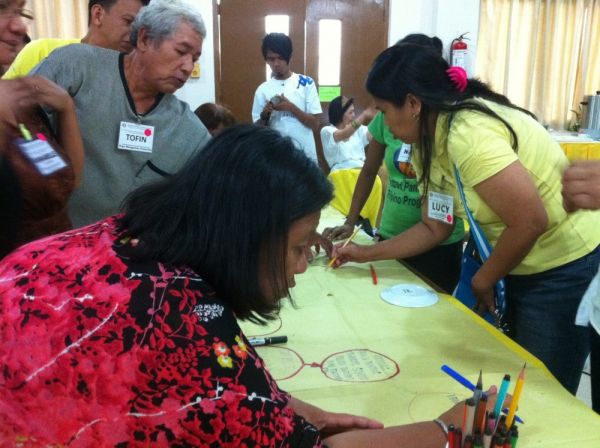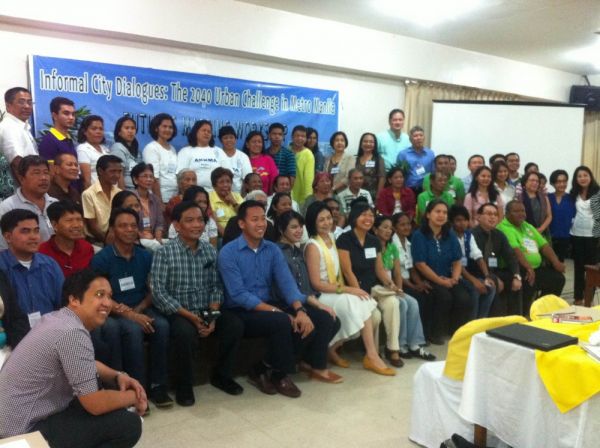“We Don’t Plant Trees, We Grow Houses”

Participants in Manila’s Futures Scenarios workshop envisioned how their city might look in the coming years and decades. Photo credit: Purple Romero
The Rockefeller Foundation’s Informal City Dialogues project recently completed its first series of workshops in all six of the cities participating. In these initial workshops, attendees were asked to participate in developing “futures” for their city. Please click here to learn more about the process, and find out what will take place in upcoming workshops.
For a moment, a group of Filipinos were spared the relentless campaign jingles and messy political paraphernalia that has surrounded them as of late, and sat instead in a room filled with generations of people who have seen Metro Manila at its best and worst – a living history of the city itself.
The local-government campaign period in the Philippines has just begun. But while the country braves the circus that is its elections, a more focused look ahead is taking place. In March, a diverse group of informal settlers, government officials, a person with disabilities, women leaders, senior citizens, youth volunteers, international observers and other Metro Manilans stripped away the layers of perennial, deep-seated problems that plague the country, and envisioned how they might affect the future.
As part of the Informal City Dialogues Inclusive Futures Mapping Workshop, the old and the young gave snapshots of what their lives were like and who they were in both the past and the present. They shared insights into the communities they lived in, torn and worn by poverty, politics and prayers.
Dr. Doy Romero of the Innovations at the Base of the Pyramid Program, of the Ateneo School of Government, described the “futures” process as indispensable to knowing what kind of future Manila could and should achieve.
“We should start with now, what drives our present,” he said. “If we don’t understand that, we won’t understand our dreams.”
On the first day of the event, a black-and-white film about Manila during the past several decades was shown to the participants, in part to showcase just how rapidly a city could change over a short time period.
A septuagenarian named Lucila de Guzman, from Doña Imelda, Quezon City, said she knew one of the local dances in the film. “I saw how it was done way back then,” she said.
Teofilo “Tofin” Morado, gray-haired, exuberant and thorough, reminisced about how Manggahan in Pasig City used to have more trees than houses. “Mango trees abounded the area,” he recalled.
Not all of the memories were pleasant. Lucila said their area used to be a dumpsite for bodies of those allegedly killed by policemen. And Tofin pointed out that the foliage along Manggahan has been replaced by shanties over time. “We don’t plant trees. We grow houses,” he joked.
And they also demolish them. De Guzman recalled how once, 500 houses were razed in a day by order of the local government. It was inevitable, she said, as they don’t own the land they built their homes on.
“We are squatters,” she said. “They used the term informal settlers to make it sound better, but the truth is they just mean the same. We live on a land that is not ours.”
This kind of resignation is part of what the futures scenarios process is designed to break through. By envisioning different versions of a future Manila, participants can see how today’s urban conditions might lead to a better or worse tomorrow. Filomena Cinco, an urban-poor leader from Estero de San Miguel, said it was important that the poor were part of this process.
“What we need is total and true participation,” she said in her fiery way. She added that reforms are best shaped by bottom-up, rather than top-down leadership, and that those in power should treat the poor as part of the solution. “We shouldn’t be seen as part of the problem but as partners in solving the problem,” she said.

Workshop participants pose for a group photo. Photo credit: Purple Romero
The workshop showed that discussion and cooperation between the urban poor, public officials and private sector representatives is possible. Representatives from government agencies, such as the Housing and Land Use Regulatory Board, the Housing and Urban Development Coordinating Council, the Department of Social Welfare and Development, the Department of Trade and Industry and the Metropolitan Manila Development Authority, among others, joined informal workers and the poor to create possible scenarios that could guide them in charting Manila’s future. As many in attendance from all stakeholder groups noted, it was a highly unusual sight, seeing senior officials from different agencies sitting, talking with and listening to people from poor communities. Such interactions usually occur between police officers and informal settlers, often in the heat of settlement demolitions — and typically, it is makeshift weapons and firearms that do the talking.
During the two-day workshop, however, there were no policemen clad in blue. There were only the government managers in casual attire, seated beside representatives from different sectors. Together, they tried to zero in on what is driving change in Manila today, and what will influence its future transformation.
All were given colorful post-its on which they wrote what changes within the physical, economic, social, environmental and institutional realm had transformed Manila and its people.
For the participants, unemployment has become worse. Crime is on the rise. They also said the spirit of bayanihan – communal cooperation – is hardly evident anymore, despite all the new forms of technology that supposedly make it easier.
Some also cited climate change as an important factor affecting Manila. The city has a severe flooding problem and the national government routinely removes informal settlers living in danger zones. This remains a point of concern among the participants even though President Benigno Aquino III has adopted in-city settlement as the government’s main relocation strategy.
Mylene Pagacpac, who is more than 20 years younger than De Guzman, said settlers understand why the government has to relocate them. What she wants, though, is for settlers to be included in deciding options for their relocation.
“We just want a fair fight,” she said. “We also want to have our own place here in Manila.”
Nancy Brion, 41, said that even if settlers are given houses, they are left with no opportunities to earn a living, to start anew in the places where the government transferred them to. “We don’t have anything, not even a penny,” she said.
And Quin Cruz, a youth leader and an elected barangay councilor who grew up in an urban-poor community in the Manggahan floodway in Pasig City, said that even if the government built medium-rise buildings to serve as new homes for informal settlers, public officials overlooked essential aspects of their welfare. There’s the size of the shelters themselves, for instance. Cruz said some rooms in the medium-rise buildings – which is what the government chose to built for in-city resettlement – are only 16 square meters, hardly enough for a family of five. It’s not uncommon for poor families to have as many as 12 kids.
Once the participants had identified a number of drivers of change, they prioritized the most important and uncertain ones that were likely to affect the future. They ultimately selected two: The first was the effectiveness of urban planning and development, and the second was the rate of population growth. Combing these two drivers gave them four possible scenarios for the future: Effective urban planning and development with rapid population growth, effective urban planning and development with slow population growth, ineffective urban planning and development with rapid population growth, and ineffective urban planning and development with slow population growth.
The participants selected a song to represent each scenario – a completely natural instinct for music-loving Filipinos. (There may be a shortage of toilets in some settlements, but rest assured that every village has a karaoke machine). The songs assigned included a folk tune on changing times called ““Kanlungan, or “Shelter,” by Noel Cabangon; a ’60s Neil Sedaka song (“Run, Samson, Run”); “Hawak Kamay,” a popular song by a local artist whose title in English means “Holding Hands,” and another local song, “Maghintay Ka Lamang,” the title of which in English translates to “Just Wait.”
While the songs helped liven up the atmosphere, the discussions quickly became serious. One group said an aging population would bring new challenges to a city already struggling with many. Or, a rapidly increasingly population could create intense competition for dwindling resources. Lackluster urban planning could exacerbate the problems that citizens have accessing basic services. Health care and disaster response could decline in quality.
The participants drew diagrams outlining possible implications of these scenarios and categorized them as physical, social, environmental, institutional or economic. Under environment, pollution, ineffective garbage disposal and lack of disaster preparedness were cited, among others. Economic problems included underemployment and contractualization, while social problems covered concerns around health, sanitation, peace and basic order.
Raising these questions together showed that dialogue is key to understanding why Manila is the way it is now and how it could be changed for the better by 2040. In the next series of workshops, participants will draw on the futures scenarios they created to develop well-informed ideas for innovations that could make the city more resilient and inclusive. Come elections on May 13, the same politicians may be installed in power. But there are emerging voices from the citizens themselves that, if taken into account, could put the country on a better course.









